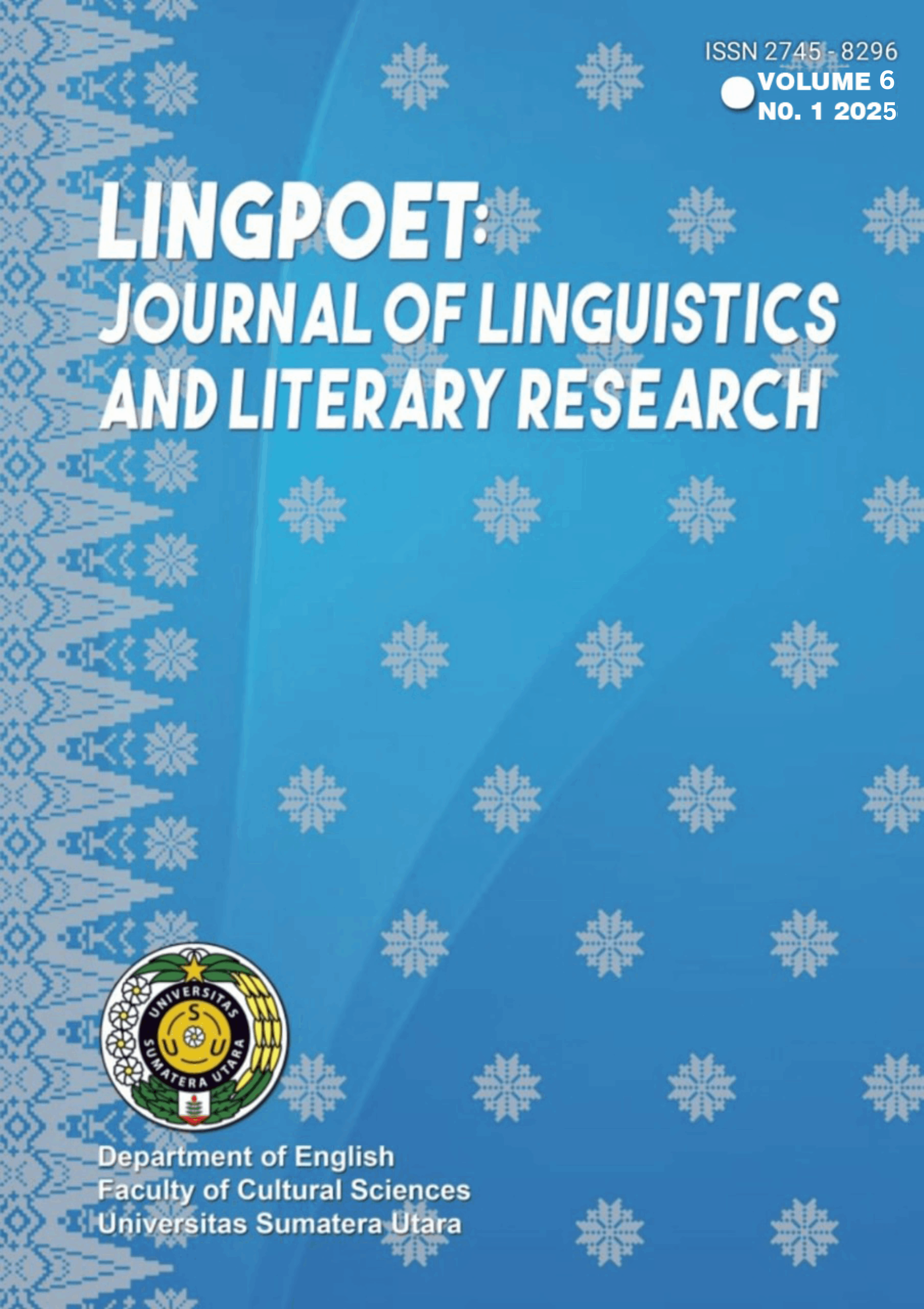Enhancing Vocabulary through English Subtitles
DOI:
https://doi.org/10.32734/lingpoet.v6i1.19901Keywords:
English as Foreign Language, Subtitle, Vocabulary.Abstract
This study aims to analyze whether the use of English subtitled movies in Frozen II can enrich and improve students' vocabulary. The researcher collected data through pre-test, treatment and post-test, to identify and classify the improvement in the movie Frozen II. This study used descriptive quantitative method. As a result, this study states that in the pre-test the average score obtained by students is only 66.7. Students who pass the KKM (minimum completeness criteria) is 12 out of 23 respondents which means that the percentage of success criteria obtained is only 52%. Then in the post-test the average score obtained by students was 86.9 with the percentage of success criteria obtained was 91%. It can be concluded that implementing English movie subtitles to enrich students' vocabulary is effective based on the research results.
Downloads
References
Abukhattala, I (2013). What Arab Students Say about Their Lingustic and Educational Experiences in Canadian Universities. International education studies, 6(8), 31-37.
Alemi, M., & Tayebi, A. (2012). The influence of incidental and intentional vocabulary acquisition and vocabulary strategy use on learning L2 vocabularies. Journal of Language Teaching and Research.
Alonso, P. R. (2019). Enhancing student motivation in foreign language learning through film subtitling projects, Online Submission, 108-126.
Apdy, A. P. R., & Asrifan, A. (2019). The Chinese mime game in teaching vocabulary on EFL classroom. In Proceedings of the 65th TEFLIN International Conference (Vol. 65, No. 01).
Creswell, J. W. (2014). Research Design: Qualitative, Quantitative, and Mixed Methods Approches (4th ed). Thousand Oaks, CA: Sage.
Davey. Cognitive Theory of Multimedia Learning in Learning Theories, Retrieved from: https://www.learning-theories.com/cognitive-theory-of multimedia-learning-mayer.html. (2015).
Djamarah, S. B., & Aswan, Z. (2016). Strategi Belajar Mengajar. Jakarta: PT Rineka Cipta.
Harefa, Y. (2009). Foundation Course in English Teaching Methods. Medan: USU Press.
Hestiana, M., & Anita,A. (2022). The Role of Movie Subtitles to Improve Students’ vocabulary. Journal of English Language Teaching and Learning, 3(1), 46–53.
Jesse, J.P. (2007). When Film Is Art.Search: what is film.www,google.co.id.Accessed in February 21th , 2024.
Klarer, M. (2004). An introduction to literary studies. New York: Routledge
Krashen, S. D. (2010). Is light reading enough to fully acquire academic language? The bridge hypothesis, Indonesian Journal of English Language Teaching, 6(1), 30-37.
Mayer, R. E. (2014). Incorporating motivation into multimedia learning. Learning and Instruction, 29, 171 173.https://doi.org/10.1016/j.learninstruc.2013.04.003.
Mery, A. (2011). Developing students writing skill by movies. Bogor: Universitas Ibnu Kholdun.
Meryani, S. (2021). Self-directed english language learning through english subtitlein indonesia film 2017. Proceedings of International Conference on English Language Teaching (INACELT), 5(1), 152–160.
Michael, P. H., & Webb, S. (2017). The effects of captions on EFL learners’ comprehension of English-language television programs. Calico Journal, 34(1), 20.
Musfiqon. (2012). Pengembangan Media dan Sumber Pembelajaran. Jakarta: PT Prestasi Pustakarya.
Read, J. (2000). Assessing Vocabulary. Cambridge: Cambridge University Press.
Taoufik, B. (2022). Investigating The Impact of Watching Movies in English on EFL Learners Vocabulary Learning Case of Second Year LMD at Mohamed Kheider University.
Sabouri, H., Zohrabi, M., & Osbouei, Z. K. (2015). The impact of watching English subtitled movies in vocabulary learning in different genders of Iranian EFL learners. International Journal on Studies in English Language and Literature, 3(2), 110–125.
Schmitt, N., & Schmitt, D (2020). Vocabulary in language teaching. Cambridge University Press.
Sherman, J. (2003). Using Authentic Video in the Language Classroom. Cambridge: Cambridge University.
Sirmandi, E. H., & Sardareh, S. A. (2016). Improving Iranian intermediate EFL learners’ vocabulary knowledge through watching video clips with English subtitles. Journal of Applied Linguistics and Language Research, 3(6), 175 187.
Sudjana. (2002). Metode Statistika. Bandung: Tarsito.
Webb, S. (2010). Pre-learning low-frequency vocabulary in second language television programmers. Language Teaching Research, 14(4), 501-515.
Downloads
Published
How to Cite
Issue
Section
License
Copyright (c) 2025 LingPoet: Journal of Linguistics and Literary Research

This work is licensed under a Creative Commons Attribution-ShareAlike 4.0 International License.













